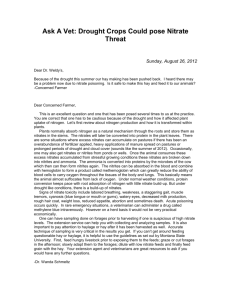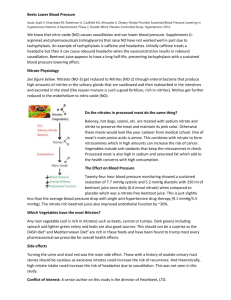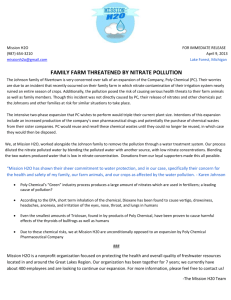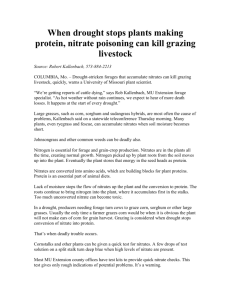Document 10745638
advertisement
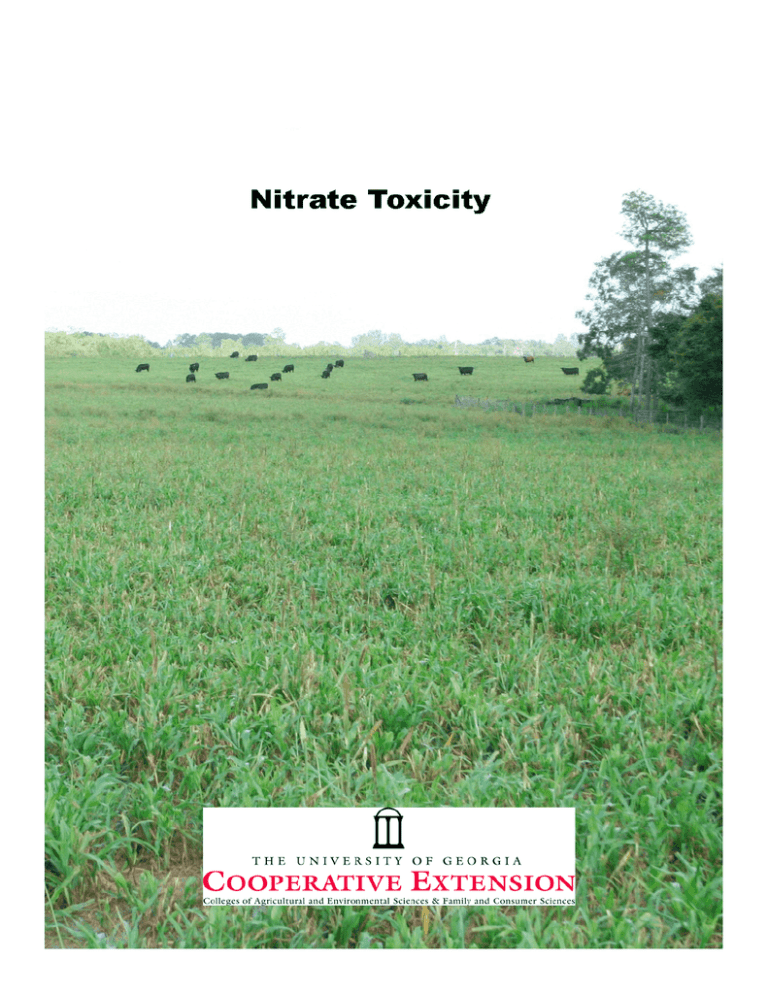
TABLE OF CONTENTS Nitrate Toxicity at a Glance . . . . . . . . . . . . . . . . . . . . . . . . . . . . . . . . . . . . . . . . 1 The Effects of High Nitrates in the Animal Diet . . . . . . . . . . . . . . . . . . . . . . . . . 1 Nitrate Accumulation in the Plant . . . . . . . . . . . . . . . . . . . . . . . . . . . . . . . . . . . . 2 Decreasing the Risk of Nitrate Toxicity . . . . . . . . . . . . . . . . . . . . . . . . . . . . . . . . 2 Reducing the Risk of Nitrate Toxicity . . . . . . . . . . . . . . . . . . . . . . . . . . . . . . . . . 2 Treatment of Acute Nitrate Poisoning . . . . . . . . . . . . . . . . . . . . . . . . . . . . . . . . . 3 Tables . . . . . . . . . . . . . . . . . . . . . . . . . . . . . . . . . . . . . . . . . . . . . . . . . . . . . . . . . 3 Nitrate Toxicity Dennis W. Hancock, Extension Forage Agronomist, Crop and Soil Sciences Department Nitrate Toxicity at a Glance: • Identify and test all forages that may have accumulated nitrates. • Nitrogen fertilization increases the risk of nitrate accumulation. • Some plants accumulate nitrates at a greater rate. • Split applications of nitrogen fertilizer (organic or inorganic) within the growing season. • Do not harvest or graze forage within seven days following a drought-ending rain. • Do not feed green chop until the whole plant has been tested for elevated nitrate concentrations. • Harvest the crop as silage when possible. • Nitrates tend to be highest in the lower stem and leaves. • Increase the harvest height to minimize the inclusion of lower plant parts and low growing weeds. • Do not graze crops closely. • Use field test kits to rule out samples low in nitrates, but confirm field results with a laboratory analysis when results indicate moderate or higher levels of nitrate (>2,500 parts per million–ppm). • Dilute high nitrate forages with feedstuffs that are high in energy. • Provide plenty of clean water and supplement with sufficient vitamins and minerals. • Avoid or minimize feeding forages that are high in nitrates to lactating, pregnant, or sick animals. • Limit animals to 3 or 4 hours of access to high-nitrate hay per day so that intake is limited to approximately 50 percent of normal. Supplement the lower hay intake by feeding a grain or by-product feed (6 to 10 pounds per day depending on lactation status and forage quality) BEFORE allowing the animals to access the high-nitrate hay. Stressful growing conditions often result in high concentrations of nitrates in plant tissue. When feeding animal forages containing toxic levels of nitrates, poor productivity or death may occur. This publication summarizes the effect that high nitrates have on the animal, presents the conditions to expect in toxic concentrations of nitrates, and outlines strategies that could prevent or reduce the risk of nitrate toxicity. noticeable. Low nitrate intake levels often cause lower milk production, abortion, breeding problems, or symptoms that mimic a nutritional deficiency (Vitamin A and E, rickets, phosphorus, or calcium imbalance). Signs of acute nitrate toxicity are a result of severe inhibition of oxygen transfer and are strikingly obvious. Symptoms include bluish color of mucous membranes, rapid and difficult breathing, a rapid pulse (>150 beats/minute), tremors, staggering, collapse, and death. A key diagnostic feature of acute nitrate toxicity is dark brown or “chocolate-colored” blood. Unfortunately, acute toxicity may appear suddenly (often within one to The Effects of High Nitrates in the Animal Diet Nitrate (NO3-) is reduced to nitrite (NO22-) by microbes in the digestive tract of cattle, sheep, goats, horses, and other animals. In most cases, the microbes further convert the nitrite to ammonia and ultimately to amino acids and proteins. However, ingestion of high concentrations of nitrates builds up nitrite levels and the nitrite is absorbed into the animal’s bloodstream. Once in the bloodstream, nitrites bind with hemoglobin (creating methemoglobin) and prevent the normal transfer of oxygen. Depending upon the amounts consumed, symptoms of nitrate poisoning may be hardly 1 two hours of ingesting toxic nitrate levels) and animals are often simply found dead. In most cases, treatment is not practical due to the rapid onset of symptoms. Thus, prevention is the primary way to combat nitrate toxicity. providing supplements (cottonseed, corn gluten, or soybean hulls) or feeding low-nitrate roughage prior to turning animals into pasture that is high in nitrates. In general, the most risky harvest method is to green chop. In addition to high initial nitrate levels, forage harvested as green chop will often undergo a heat cycle that increases the conversion of nitrates to nitrites. In contrast, ensiling tends to reduce the nitrate content of forages by 30 to 60 percent. However, employ proper ensiling techniques. Forage that is too dry, poorly packed, or fed too early may have not fermented or reduced nitrate levels sufficiently. Hay harvest may also be a feasible option, but nitrate concentrations DO NOT change substantially when stored as hay. Avoid elevated nitrate concentrations in the lower parts of the plant stem and any low growing weeds by raising the cutting height. For example, corn silage harvested at 6’ to 8’ may be 20 to 25 percent lower in nitrate concentration than when harvested at a height of 2’ to 4’. Similarly, sufficiently lowering stocking rates will help prevent animals from grazing too closely to the forage. However, higher harvest heights result in significant yield reductions. Nitrate Accumulation in the Plant Plants take up nitrogen primarily in the form of nitrate. Early in the plant’s growth, nitrate uptake is relatively high and nitrates may become concentrated. As plant growth slows, the plant continues to take up nitrates, but the nitrates do not convert to amino acids and proteins. This causes a buildup of nitrates in the plant. Periods of drought or cloudy weather that slows the rate of photosynthesis are often associated with slowed plant growth and the accumulation of nitrates. Plants in vegetative stages are most likely to have high nitrate levels. In addition, nitrates are more highly concentrated in stems and leaves closer to the soil surface. Rapid uptake of nitrates during the first few hours following a drought-ending rain may also cause nitrate levels to be high. The conversion of nitrates to amino acids within the plant may take several days. Thus, expect nitrates to remain very concentrated for seven or more days after the crop has received enough rain to sustain growth. Forage crops that receive high nitrogen fertilization are more likely to contain high nitrate concentrations. Thus, it is common for summer annuals, warm-season perennials, and small grains to have high nitrates (Table 1 on page 3). In addition, many common weed species naturally accumulate high levels of nitrates. It is difficult to predict when high nitrate levels will occur because of the various rates of fertilizer application, variable weather conditions, and the variety of crops grown for pasture, hay, and silage. Therefore, when weather or management are suspected factors in creating the potential for toxicity, evaluate the levels of nitrate in the forage. Reducing the Risk of Nitrate Toxicity To prevent nitrate toxicity, producers should test several representative samples from any forage suspected to be high in nitrates. It is common for some portion of the forage lot to be extremely high in nitrates, while other portions are safe. A major cause of this variation is variability in the productivity within a field (i.e., droughty soils, zones with higher weed pressures, etc.). Thus, it is best to test the forage prior to harvest when possible. This is important for two reasons. First, it gives as much time as possible to receive accurate results from a laboratory analysis. Second, suspected “hot spots” within the field can be identified and sampled accordingly. Forage from these “hot spots” may hide within the lot during harvest and may or may not be represented if the hay lot or silage is sampled prior to feeding. Test kits that approximate nitrate concentration in the forage are commercially available for use in the field. Most county extension offices have field kits to test for high nitrate concentrations and your local County Extension Agent may be available to help you to do a field evaluation. Though the field test kit may be a very useful screening tool, forages that test positive for moderate or higher levels of nitrate (for example, values greater than 2,500 ppm in forage for beef cattle) should undergo quantitative analysis in the laboratory. For the development of rations that safely dilute the nitrate, the nitrate concentration in the forage needs to be accurately determined. Decreasing the Risk of Nitrate Toxicity Fertilization - Nitrogen fertilization is critical to high forage yields. However, splitting the nitrogen applications throughout the growing season rather than applying the full rate at the beginning of the season reduces the risk of high nitrate concentrations. Furthermore, plants may also have higher nitrate concentrations when soils are deficient in other major nutrients (phosphorus, potassium, etc.). Harvest techniques - Harvest management also plays a critical role in lowering the risk associated with nitrate toxicity. Animals may graze forages with high nitrate concentrations, but producers should limit the intake of such forage. Effectively limit the total nitrate intake by 2 For a small fee, submit samples for nitrate analysis to the University of Georgia’s Agricultural and Environmental Services Laboratories (AESL) in Athens, Georgia (http://aesl.ces.uga.edu/). Visit with your local county extension agent for submission procedures. The results of the laboratory analysis from the AESL is reported as the concentration of nitrate in parts per million (ppm) of the dry forage. Table 2, below, provides management guidance for the safe use of forages containing increasing levels of nitrates when feeding beef cattle. Other animal classes may have different critical values. For example, dairy cattle may begin to exhibit sub-clinical symptoms at nitrate concentrations above 1,000 ppm. In contrast, there is some evidence that hay containing nitrate concentrations up to 10,000 ppm can be safely fed to horses. BEFORE using high nitrate forages in a feeding program, consult your veterinarian. If the laboratory analysis indicates moderate to high levels of nitrate (>4,500 ppm), the forage can still be fed to most beef cattle if it is managed properly. One management option is to dilute the nitrate concentration by blending the high nitrate forage with feedstuffs that are low in nitrates. In many cases, growing animals (non-lactating, non-gestating) may become acclimated to higher nitrate levels by slowly increasing the proportion of higher nitrate feed. However, producers should minimize or avoid feeding forages that are high in nitrates to lactating, pregnant, or sick animals. Supplementation with grain, grain by-products, and other feedstuffs that are high in energy may aid the conversion of nitrite to ammonia and reduce the risk of nitrate toxicity. Vitamin and mineral supplementation may also help to counter sub-clinical toxicity symptoms. Keeping plenty of clean water available to the animal will also help dilute nitrate concentrations. Treatment of Acute Nitrate Poisoning Although prevention is the primary method of combating nitrate toxicity, there are some treatment options when nitrate poisoning is diagnosed. The rapid onset of nitrate toxicity requires quick action. Counteract acute nitrate poisoning by slowly administering an intravenous solution of methylene blue in isotonic saline (1% W/V). Methylene blue reduces methemoglobin to oxyhemoglobin, restoring the blood’s ability to exchange oxygen. Repeat the treatment in 15 to 30 minutes, if needed. Before any treatment, consult your veterinarian. Tables Table 1. A selection of common plants known to accumulate nitrates. Grasses Forbs Bermudagrass Rescuegrass Cudweed Brown top millet Rye Dock Crabgrass Ryegrass Horsenettle Corn Sorghum Jimsonweed Tall fescue Sudangrass Lambsquarter Johnsongrass Sorghum x Sudan Nightshade Oats Wheat Pigweed Pearl millet Table 2. Management of various nitrate levels in beef cattle rations. Forage Nitrate (ppm dry forage) <4,500 Guidance Safe to feed with adequate feed and water 4,500 - 6,500 Safe under most conditions but, if feeding pregnant animals, restrict to one-half (1/2) of the ration 6,500 - 9,000 Limit to one-half (1/2) of the ration 9,000 - 15,000 Limit to one-third (1/3) of the ration 15,000 - 18,000 Limit to one-quarter (1/4) of the ration >18,000 Potentially lethal, very risky, dilute carefully 3 The University of Georgia and Ft. Valley State University, the U.S. Department of Agriculture and counties of the state cooperating. Cooperative Extension, the University of Georgia College of Agricultural and Environmental Sciences, offers educational programs, assistance and materials to all people without regard to race, color, national origin, age, gender or disability. An Equal Opportunity Employer/Affirmative Action Organization Committed to a Diverse Work Force C915 July 2007 Issued in furtherance of Cooperative Extension work, Acts of May 8 and June 30, 1914, The University of Georgia College of Agricultural and Environmental Sciences and the U.S. Department of Agriculture cooperating. J. Scott Angle, Dean and Director

